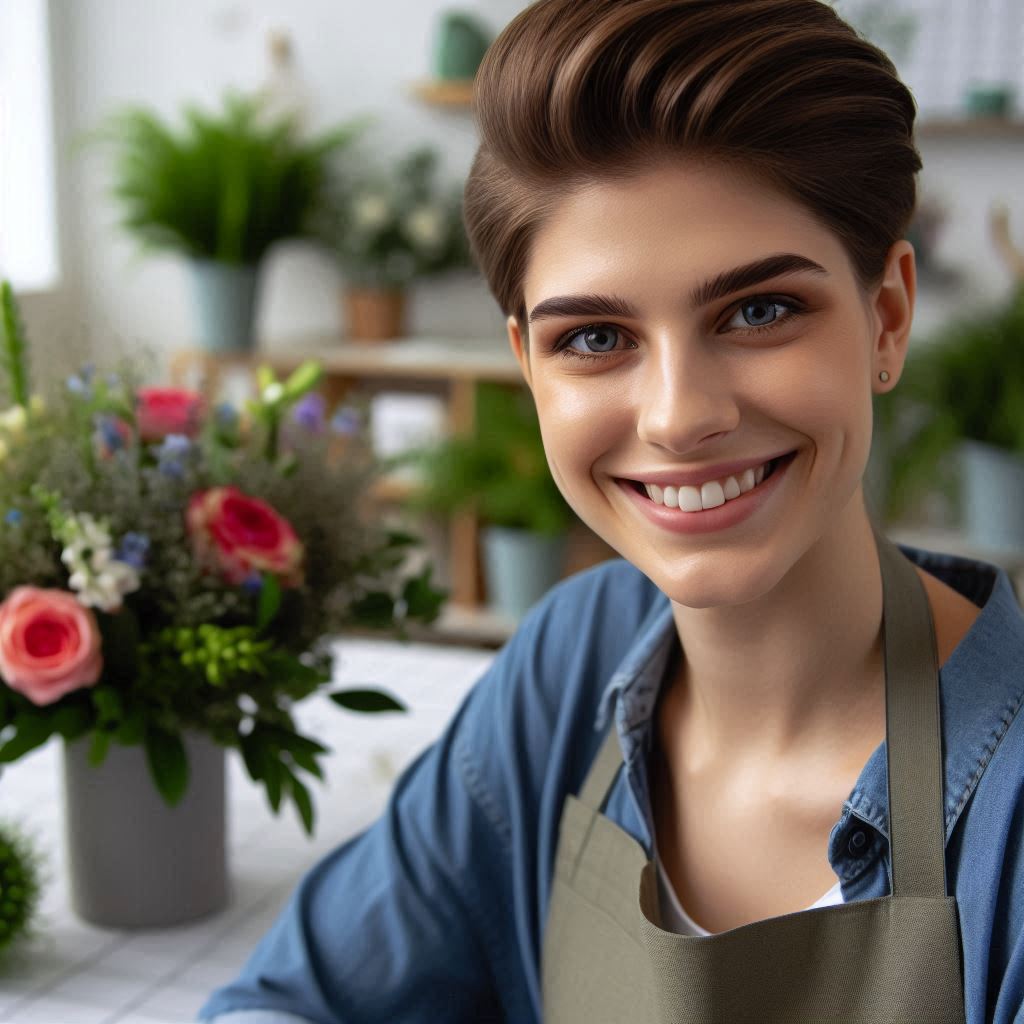Introduction
Sustainable floral design focuses on creating beautiful arrangements while minimizing environmental impact.
This practice promotes using eco-friendly materials and methods throughout the floral industry.
Traditional floral design often involves non-biodegradable products and harmful chemicals.
In contrast, sustainable floral design prioritizes natural resources and their preservation.
Eco-friendly practices in floral design are essential for several reasons.
First, they help reduce waste by using biodegradable materials.
This includes natural twine, compostable packaging, and organic flowers.
Second, sustainable practices support local growers, reducing carbon footprints from transportation.
Sourcing flowers locally encourages community engagement and helps small businesses thrive.
Additionally, sustainable floral design promotes biodiversity.
Choosing seasonal and native plants encourages the growth of local ecosystems.
This practice helps protect pollinators, which are crucial for plant health and reproduction.
Moreover, sustainable floral designers often use repurposed materials, like vintage vases and reclaimed wood, adding unique charm to their arrangements.
Adopting eco-friendly practices also raises awareness among consumers.
Clients become more informed about the environmental impact of their choices.
As a result, they often prefer sustainable options, creating a demand for greener practices in the industry.
Ultimately, sustainable floral design represents a holistic approach to creativity and environmental stewardship.
It allows florists to create stunning arrangements while protecting the planet for future generations.
Embracing these practices is vital for the floral industry’s future and the health of our ecosystems.
Use of locally sourced flowers and greenery
Benefits of Using Locally Sourced Flowers
Using locally sourced flowers and greenery in sustainable floral design practices has numerous benefits.
Transform Your Career Today
Unlock a personalized career strategy that drives real results. Get tailored advice and a roadmap designed just for you.
Start NowFirstly, locally grown flowers are fresher and have a longer vase life compared to imported blooms.
This means your floral arrangements will remain vibrant and beautiful for a longer period of time.
Additionally, locally sourced flowers support the local economy and help small-scale farmers thrive.
By purchasing flowers from local growers, you are contributing to the growth of the community and helping to sustain local businesses.
This creates a positive impact on the local economy and helps to strengthen the community as a whole.
Furthermore, using locally sourced flowers also helps to reduce carbon footprint.
Imported flowers are often transported over long distances, which contributes to greenhouse gas emissions and air pollution.
By choosing flowers that are grown locally, you are reducing the environmental impact of your floral arrangements and promoting sustainability.
Supporting Local Farmers and Reducing Carbon Footprint
One of the key advantages of using locally sourced flowers and greenery in sustainable floral design is the direct support provided to local farmers.
When you buy flowers from local growers, you are helping them sustain their livelihoods and encouraging the growth of the local agricultural industry.
By supporting local farmers, you are also reducing the need for long-distance transportation of flowers.
This helps to lower carbon emissions associated with the transportation of imported flowers and contributes to a more eco-friendly floral industry.
By choosing locally sourced blooms, you are taking a step towards a more sustainable and environmentally friendly floral design practice.
Tips on Finding Local Flower Sources
Finding local flower sources for your sustainable floral design projects can be a rewarding experience.
Here are some tips to help you locate and support local flower growers:
- Visit farmers markets: Farmers markets are a great place to find locally grown flowers and greenery.
You can directly connect with the growers and learn more about their farming practices. - Join a community-supported agriculture (CSA) program: Many local farms offer CSA programs where you can subscribe to receive seasonal flowers on a regular basis.
This is a convenient way to support local farmers and access fresh blooms. - Research online directories: There are online directories that list local flower growers and florists in your area.
These resources can help you discover new sources for locally grown flowers for your sustainable floral designs. - Reach out to local florists: Local florists often source flowers from nearby growers.
By establishing a relationship with a local florist, you can access a variety of locally grown flowers for your floral arrangements.
By following these tips and actively seeking out local flower sources, you can support local farmers, reduce carbon footprint, and create stunning sustainable floral designs that benefit both the environment and the community.
Read: Floral Design Internships: Where to Find Them
Avoiding the use of floral foam
Negative environmental impact of floral foam
Floral foam has been a standard in floral design for years.
However, its negative environmental impact raises serious concerns.
Showcase Your Business Today
Reach thousands of readers actively exploring professional services. Publish your business profile and grow your audience now.
Publish NowMade from non-biodegradable materials, floral foam contributes to landfill waste.
It also leaches harmful chemicals into the environment.
These chemicals can pollute soil and water, affecting local ecosystems.
Alternatives to floral foam
Fortunately, several eco-friendly alternatives exist.
Chicken wire is a popular choice for floral arrangements.
It provides excellent support for stems and allows water to reach the flowers.
Simply shape the chicken wire into a grid and place it in your container.
This method is sustainable and promotes healthier blooms.
Another alternative is oasis bio foam.
This foam is biodegradable and made from natural materials.
It holds water effectively while being less harmful to the environment.
You can use it in a similar way to traditional floral foam, providing stability for your arrangements.
How to create arrangements without floral foam
Creating arrangements without floral foam is easier than you think.
Begin by selecting a sturdy container with drainage holes.
Fill it with fresh water and add chicken wire or oasis bio foam if desired.
Cut flower stems at an angle to encourage water absorption.
Arrange the flowers naturally, allowing for a more organic look.
You can also use natural materials, like twigs or stones, to support stems.
These materials add texture and interest to your design.
Emphasizing seasonal and locally sourced flowers further reduces your environmental footprint.
By avoiding floral foam, you contribute to a healthier planet.
Implementing eco-friendly practices in floral design inspires others to do the same.
Together, we can create beautiful arrangements while caring for our environment.
Read: Floral Design Certification: Do You Need It?
Opting for organic and natural materials
Benefits of using organic flowers and materials
Using organic flowers and materials in your floral designs can have numerous benefits.
Firstly, organic flowers are grown without the use of synthetic pesticides, herbicides, or fertilizers.
This helps to protect the health of the farmers, consumers, and the environment.
Organic farming practices also prioritize the well-being of the soil, water, and ecosystem as a whole.
By choosing organic flowers and materials, you are supporting sustainable agriculture and promoting biodiversity.
Furthermore, organic flowers are often more fragrant and have longer-lasting blooms compared to conventionally grown flowers.
This means your floral arrangements will not only be beautiful but also eco-friendly and sustainable.
Harmful effects of pesticides on the environment
Pesticides used in conventional flower farming can have devastating effects on the environment.
These chemicals can contaminate soil, water sources, and air, leading to pollution and harm to wildlife.
In addition, pesticides have been linked to the decline of bee populations and other beneficial insects essential for pollination.
By choosing organic flowers, you are helping to protect these important pollinators and preserve biodiversity.
Moreover, pesticide runoff from conventional flower farms can leach into nearby waterways, causing harm to aquatic ecosystems and threatening the health of aquatic life.
Opting for organic flowers can help mitigate these harmful effects on the environment.
How to identify organic flowers and materials
When selecting flowers for your sustainable floral designs, look for certifications such as USDA Organic or Certified Naturally Grown.
These labels indicate that the flowers have been grown using organic practices and have met strict standards for sustainability.
You can also inquire with your local florists or flower suppliers about their sourcing practices.
Showcase Your Business Today
Reach thousands of readers actively exploring professional services. Publish your business profile and grow your audience now.
Publish NowMany eco-conscious florists are transparent about where they source their flowers from and are happy to provide information on their sustainability efforts.
Additionally, consider growing your own organic flowers or sourcing from local farmers markets to ensure the freshness and eco-friendliness of your floral materials.
By taking these steps, you can create stunning floral arrangements that are not only beautiful but also environmentally responsible.
Read: Freelance Floral Design: How to Get Started

Composting floral waste
Floral waste is a common byproduct of the floral industry, including discarded flowers, leaves, and stems…
When these materials are sent to landfills, they decompose anaerobically, releasing harmful greenhouse gases like methane…
Importance of composting floral waste
Composting floral waste helps reduce greenhouse gas emissions and diverts organic material from landfills…
It also enriches soil with valuable nutrients, promoting healthier plant growth and reducing the need for synthetic fertilizers…
How to properly compost floral waste
Start by collecting organic floral waste in a separate container, ensuring it is free of non-biodegradable materials…
Layer the waste with carbon-rich materials like shredded newspaper or dried leaves to provide a balanced mixture…
Benefits of composting for the environment
Composting floral waste helps close the nutrient loop by returning valuable organic matter back to the soil…
It reduces the demand for chemical fertilizers, conserves water, and supports a healthy ecosystem by improving soil health…
In short, composting floral waste is a simple yet effective way to reduce waste, minimize environmental impact, and support sustainable practices in the floral industry.
By following proper composting techniques, we can turn what was once considered waste into a valuable resource for our planet.
Read: How to Market Your Floral Design Services Effectively
Reusing and repurposing floral arrangements
One eco-friendly practice in sustainable floral design is the reuse and repurposing of floral arrangements.
This approach not only helps reduce waste but also allows you to get the most out of your flowers and greenery.
Ways to reuse flowers from one arrangement to another
- After your initial floral arrangement starts to wilt, carefully remove the still-fresh flowers.
- Trim the stems and place them in a clean vase with fresh water to extend their life.
- You can also combine these reused flowers with new blooms to create a fresh arrangement.
Creative ways to repurpose wilted flowers and greenery
- Dry the flowers by hanging them upside down or pressing them between heavy books.
- Use dried flowers and greenery for crafts like wreaths, potpourri, or homemade cards.
- Create a DIY floral art piece by arranging dried flowers on canvas and framing it.
Benefits of extending the life of floral arrangements
- Reducing waste by reusing flowers minimizes the environmental impact of floral design.
- Extending the life of arrangements saves money by getting more use out of your flowers.
- Repurposing wilted flowers allows you to enjoy their beauty even after they fade.
- By practicing these eco-friendly habits, you contribute to a more sustainable floral industry.
Overall, reusing and repurposing floral arrangements is a simple and effective way to create beautiful designs while minimizing waste.
By being mindful of how you handle your flowers, you can enjoy them for longer and reduce your environmental footprint in the process.
Choosing sustainable packaging
Flower arrangements are not just about the blooms themselves but also the packaging they come in.
Choosing sustainable packaging is essential for eco-friendly practices in floral design.
Impact of non-biodegradable packaging on the environment
Traditional plastic packaging contributes to pollution and waste in landfills and oceans.
These materials take hundreds of years to decompose, causing long-term harm to the environment.
The production of plastic packaging releases harmful chemicals into the atmosphere.
Alternatives to traditional plastic packaging
Biodegradable wrapping made from materials like cornstarch or plant-based plastics.
Recycled paper or cardboard can be used for packaging floral arrangements.
Reusable and sustainable options such as glass jars or metal containers.
Tips on eco-friendly packaging options for floral arrangements
- Avoid single-use plastics and opt for biodegradable or reusable materials.
- Choose packaging materials that can be easily recycled or composted.
- Consider using natural elements like leaves or twine for a more organic touch.
- Support local artisans who create handmade packaging using sustainable materials.
By consciously selecting sustainable packaging for your floral designs, you can reduce your carbon footprint and contribute to a healthier planet.
Find Out More: The Future of Typography: Trends to Watch
Educating Clients on Sustainable Floral Design
When it comes to sustainable floral design, educating clients is key to promoting eco-friendly practices.
Importance of Informing Clients About Eco-Friendly Practices
- Ensures clients understand the environmental impact of traditional floral arrangements.
- Empowers clients to make informed choices that align with their values.
- Helps foster a culture of sustainability within the floral industry.
How to Communicate the Benefits of Sustainable Floral Design to Clients
- Highlight the use of locally sourced, seasonal flowers to reduce carbon footprint.
- Emphasize the benefits of organic and pesticide-free blooms for health and the environment.
- Showcase the longevity of sustainable arrangements, reducing waste and costs for clients.
Encouraging Clients to Support Sustainable Floral Businesses
- Offer incentives such as discounts or promotions for choosing eco-friendly options.
- Educate clients on the positive impact of supporting sustainable practices in the floral industry.
- Showcase success stories of other clients who have embraced sustainable floral design.
By actively engaging with clients and demonstrating the value of sustainable floral design, businesses can encourage a shift towards more eco-friendly practices in the industry.
Conclusion
Sustainable floral design is crucial for preserving our environment and promoting social responsibility.
Florists should prioritize eco-friendly practices to reduce waste and minimize their ecological footprint.
I encourage all floral designers to educate themselves on sustainable techniques and implement them in their work.
Together, we can make a positive impact on the planet and support a greener future.
I urge readers to choose florists who prioritize sustainability and support eco-conscious businesses.
Let‘s all work together to create a more sustainable floral industry and protect our beautiful planet.
[E-Books for Sale]
The Big Book of 500 High-Paying Jobs in America: Unlock Your Earning Potential
$19.99 • 500 High-Paying Jobs • 330 pages
Explore 500 high-paying jobs in America and learn how to boost your career, earn more, and achieve success!
See All 500 High-Paying Jobs of this E-Book
1001 Professions Without a Degree: High-Paying American Jobs You Can Start Now
$19.99 • 1001 Professions Without a Degree • 174 pages
Discover 1001 high-paying jobs without a degree! Unlock career tips, skills, and success strategies for just $19.99!




